
A digital camera is a camera that captures photographs in digital memory. Most cameras produced today are digital, largely replacing those that capture images on photographic film. Digital cameras are now widely incorporated into mobile devices like smartphones with the same or more capabilities and features of dedicated cameras. High-end, high-definition dedicated cameras are still commonly used by professionals and those who desire to take higher-quality photographs.
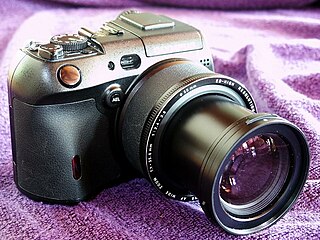
The Olympus C-8080 WZ is a digital camera formerly manufactured by Olympus. It was first announced on the opening day of the 2004 Photo Marketing Association Annual Convention and Trade Show. At the time, the C-8080 was set to be Olympus’ first eight-megapixel digital camera for the high-end consumer market. The MSRP was $1,149 USD.

A point-and-shoot camera, also known as a compact camera and sometimes abbreviated to P&S, is a still camera designed primarily for simple operation. Most use focus free lenses or autofocus for focusing, automatic systems for setting the exposure options, and have flash units built in. They are popular for vernacular photography by people who do not consider themselves photographers but want easy-to-use cameras for snapshots of vacations, parties, reunions and other events.

The Pentax Auto 110 and Pentax Auto 110 Super were fully automatic single-lens reflex cameras manufactured by Asahi Pentax for use with Kodak 110 film cartridges. The Auto 110 was introduced with three interchangeable, fixed focal length lenses in 1978. A further three lenses were added in 1981 to coincide with the release of the Auto 110 Super the following year. The camera system was sold until 1985. The complete system is sometimes known as the Pentax System 10, apparently for its official Pentax name, although most Pentax advertising only uses the camera name or Pentax-110. This model represented the only complete ultraminiature SLR system manufactured for the 110 film format, although several fixed-lens 110 SLRs were sold. The camera system also claims to be the smallest interchangeable-lens SLR system ever created.

A digital single-lens reflex camera is a digital camera that combines the optics and the mechanisms of a single-lens reflex camera with a digital imaging sensor.
The Olympus AZ-4 Zoom is a 35mm fixed-lens SLR camera introduced in 1989.

The Sony Cyber-shot DSC-R1 is a bridge digital camera announced by Sony in 2005. It featured a 10.3 megapixel APS-C CMOS sensor, a size typically used in DSLRs and rarely used in bridge cameras. This was the first time such a large sensor was incorporated into a bridge camera. Besides the APS-C sensor, the DSC-R1 also featured a 14.3–71.5 mm Carl Zeiss Vario-Sonnar T* lens, providing for an angle of view equivalent to 24–120 mm on a full frame camera.
The Kodak EasyShare V570 was a 5-megapixel digital camera manufactured by Eastman Kodak. Announced on January 2, 2006, it was an upper-end model in the consumer price range, advertised at $400 in the United States in January 2006. It had an innovative dual lens system, combining two periscopic groups each with its own sensor: one very wide angle equivalent to a 23 mm in 135 format and a 3X zoom equivalent to a 39–117 mm, totalizing a virtual 5X zoom, with a step between 23 and 39 mm. It is the first dual lens digital camera. The model won a gold medal in the 2006 Industrial Design Excellence Awards.
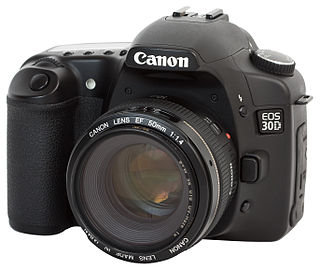
The Canon EOS 30D is an 8.2-megapixel semi-professional digital single-lens reflex camera, initially announced on February 21, 2006. It is the successor of the Canon EOS 20D, and is succeeded by the EOS 40D. It can accept EF and EF-S lenses, and like its predecessor, it uses an APS-C sized image sensor, so it does not require the larger imaging circle necessary for 35 mm film and 'full-frame' digital cameras.
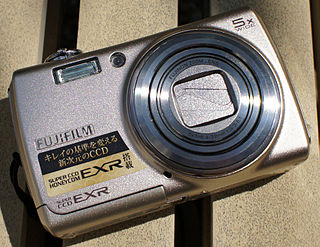
The Fujifilm FinePix F series is a line of compact digital cameras that was known for its low-light performance in 2005, with relatively low image noise and natural colors even at high ISO settings. With its relatively large, but moderate resolution Super CCD sensors, it concentrated on image quality, and low-light shooting without flash, which was mostly restricted to prosumer models at the time.

Panasonic Lumix DMC-FZ50 is a superzoom bridge digital camera by Panasonic.
General Imaging was a manufacturer of digital cameras headquartered in Torrance, California, established in 2006 by Hiroshi "Hugh" Komiya, a former executive of Olympus Corporation. General Imaging sold their cameras internationally under the General Electric name, used under license. In Japan, General Imaging was licensed to manufacture and sell their cameras under the AgfaPhoto name. General Imaging filed for bankruptcy on October 5, 2015.

The Micro Four Thirds system is a standard released by Olympus and Panasonic in 2008, for the design and development of mirrorless interchangeable lens digital cameras, camcorders and lenses. Camera bodies are available from Blackmagic, DJI, JVC, Kodak, Olympus, Panasonic, Sharp, and Xiaomi. MFT lenses are produced by Cosina Voigtländer, DJI, Kowa, Kodak, Mitakon, Olympus, Panasonic, Samyang, Sharp, Sigma, SLR Magic, Tamron, Tokina, TTArtisan, Veydra, Xiaomi, Laowa, Yongnuo, Zonlai, Lensbaby, Kowa, Venus Optics and 7artisans amongst others.

The Panasonic Lumix DMC-GH1 is a digital mirrorless interchangeable lens camera adhering to the Olympus and Panasonic developed Micro Four Thirds System (MFT) system design standard. Panasonic classified the GH1 as a hybrid stills/video camera and the GH1 was introduced and marketed as a higher end camera than Panasonic's first MFT camera, the stills only, non-video capable Lumix DMC-G1.
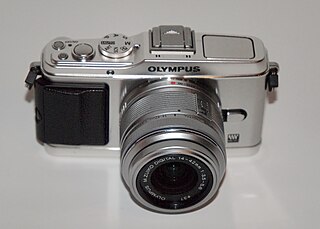
The Olympus PEN E-P3 announced on 30 June 2011 is Olympus Corporation's seventh camera that adheres to the Micro Four Thirds (MFT) system design standard. The E-P3 succeeds the Olympus PEN E-P2, and was announced in concert with two other models, the Olympus PEN E-PL3, and the Olympus PEN E-PM1.
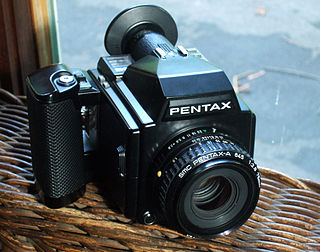
The Pentax 645 is a medium format single-lens reflex system camera manufactured by Pentax. It was introduced in 1984, along with a complementary line of lenses. It captures images nominally 6 cm × 4.5 cm on 120, 220, and 70 mm film, though the actual size of the images is 56 mm × 41.5 mm.
The Sony Cyber-shot DSC-RX100 series is a high-end compact camera series. It started with the DSC-RX100, announced on 6 June 2012, and is part of the Cyber-shot RX line of digital cameras made by Sony. Seven annual generations have been released so far until 2019, all equipped with a one-inch 20-Megapixel image sensor and rotary knob around the lens. Filming at up to 1080p at 60fps is supported by the first three generations, the third additionally with 720p at 120fps, and up to 2160p (4K) at 30fps and 1080p at 120fps high frame rate video since the fourth.

Announced by Sony on August 24, 2011, and launched alongside its brother the Sony Alpha 77, the Sony Alpha 65 is the top-tier for Sony's midrange Alpha SLT camera line.

The Fujifilm FinePix HS50EXR is a DSLR styled ultra-zoom bridge camera announced by Fujifilm on January 7, 2013. It is the last model of the Fujifilm FinePix HS series. At the time of its release, it competed most closely with the Canon PowerShot SX50 HS, another ultra-zoom bridge camera with raw capability. The SX50 has 20% longer maximum effective focal length, but the HS50 has 33% more resolution on the sensor.

The Canon EOS R is a 30.3 megapixel full-frame mirrorless interchangeable-lens camera launched by Canon in October 2018.

















